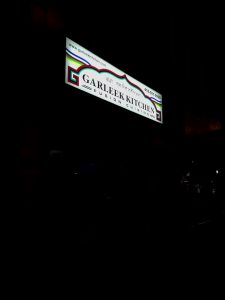My first impression of Little Tibet was that it had delicious Tibetan food! I decided to eat dinner at Garleek Kitchen, located in the heart of Little Tibet on Queen Street West (see Figure 3). The thukpa, which is a Tibetan noodle soup, was delicious, but was only one option of many on the menu. Garleek offers teriyaki, which hails from Japan, American chili, and dum aloo which is an Indian dish. These food options reflect and support the diversity of the neighbourhood. As Ahmad Jamal notes, “Retailers of different ethnic background in such a context play the role of cultural intermediaries who facilitate this culture swapping by promoting coexistence, tolerance and freedom of lifestyles among consumers of different ethnic backgrounds” (2003). While Tibetans have formed a large concentration within Little Tibet, people from Nepal and India have also immigrated to the area and these diverse food options are ways in which they can be accommodated not by the state, but by the Tibetan community.
There is a strong sense of pride in being from Tibet which is clear in the physical landscape of the enclave. Restaurants have names like ‘Tibet Kitchen’, ‘Little Tibet Restaurant’, and ‘Tashi Delek Cafe’, the final of which is a popular Tibetan greeting. The names of these restaurants are also good for business. In their research, Kiwon Kim and Melissa Baker found that “using an ethnic menu name and possessing employees of referent ethnic origin have the largest impacts on customer perceptions of authenticity” (2017). This win-win situation indicates that restaurants which reference Tibet and offer Tibetan food should continue to open in the neighbourhood. It draws customers who crave an authentic experience and helps Tibetans show their pride in their country while remaining apolitical should they wish to. Restaurants also provide employment opportunities for Tibetan immigrants. From 1980 to 2016, 41.6% of immigrants to High Park-Parkdale were economic immigrants (City of Toronto, 2018). With this in mind, restaurants take on a new significance as a relatively low-barrier way to enter the workforce for Tibetans immigrating to Canada.
Other than restaurants, one other major institution which accommodates Tibetans is the Parkdale Collegiate Institute (PCI). Much like the restaurants, the PCI is located at the intersection of Jameson Avenue and Queen Street, in the centre of Little Tibet. 40% of PCI’s student body is Tibetan according to Chemi Lhamo (ZenZatva, 2016), and 57% of current students speak a primary language other than English (Toronto District School Board, 2014). This school not only educates young members of the Tibetan community, it offers a meeting space for other activities that are important aspects of Tibetan culture. Every Wednesday in the summer, for example, the traditional dance of lhakar is offered on the school grounds. Kevin Lynch points to the importance of landmarks as an element of built form (1960). The large building located at an important intersection combined with the services it offers Tibetan community members make this site a landmark within the enclave.

Figure 1: The sign for Garleek Kitchen, a Tibetan restaurant
List of Figures
Figure 3: Photograph taken by author.
References
City of Toronto. (2018). City of Toronto Ward Profiles, Ward 4: Parkdale- High Park. Toronto: City of Toronto, https://www.toronto.ca/wp-content/uploads/2018/09/8f6b-City_Planning_2016_Census_Profile_2018_25Wards_Ward04.pdf.
Jamal, A. (2003). Retailing in a multicultural world: the interplay of retailing, ethnic identity and consumption. Journal Of Retailing And Consumer Services, 10(1), 1-11. doi: 10.1016/s0969-6989(02)00059-0
Kim, K., & Baker, M. (2017). The Impacts of Service Provider Name, Ethnicity, and Menu Information on Perceived Authenticity and Behaviors. Cornell Hospitality Quarterly, 58(3), 312-318. doi: 10.1177/1938965516686107
Lynch, K. (1960). The Use of the Method. In The Image of the City (1st ed., pp. 140-159). Boston: MIT Press.
The Star. (2008). ‘At home’ in Little Tibet. Retrieved from https://www.thestar.com/news/gta/2008/05/15/at_home_in_little_tibet.html
Toronto District School Board > Find your… > Schools > Facts and Figures. (2014). Retrieved 19 October 2019, from https://www.tdsb.on.ca/Find-your/Schools/Facts-and-Figures/schno/5550
ZenZatva. (2016). Little Tibet in Toronto – Part 2 [Image]. Retrieved from https://www.youtube.com/watch?v=g0URKKqMT4c
